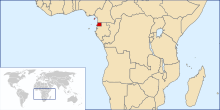
The cuisine of Equatorial Guinea is a blend of the cuisines of the native peoples of this African country, including the Annobonese, the Bubi, the Fang, and the Kombe. It is also influenced by the cuisines of Spain (which colonized the country until 1968); other African nations such as Nigeria and Cameroon; Islamic states such as Morocco; and Creole cuisine overall. Its cuisine incorporates various meats, including game and bushmeat as well as imports, and is known for its strong flavors and high spice levels. Fish and chicken are common dishes.
While recipes vary from one community to another, the country's ethnic groups largely use the same ingredients.[1] Soups and stews predominate. Tubers like yuca and yam, traditionally served boiled or fried, serve as the base of the Equatoguinean diet. The tropical climate favors the cultivation of a multitude of vegetables, like eggplant, and fruits, like atanga. The jungle is a source for aromatic herbs and wild game.[2] Not unexpectedly, as fishing is a way of life for a large portion of Equatoguineans, the country's signature dish is pepesup (peppersoup), a spicy fish soup.[3] Meals generally center around stewed sauces. Dishes cooked wrapped in banana leaves are also common. Main dishes are usually accompanied by rice or boiled or fried yuca, malanga, or plantain. Dishes adopted from other countries include the Spanish tortilla and the Cameroonian ndolé.
Chilies and other spices are popular. Key ingredients in Equatoguinean cuisine come from local plants and animals, including plantains, sweet potato, breadfruit, cassava, yam, cocoyam (known locally as malanga), groundnuts, and snails.
As for desserts, a highlight is the dish akwadu, which features baked bananas with coconut. For drinks, specialties include topé (palm wine) and malamba.[4] Equatoguinean coffee and cocoa production peaked during the colonial period but has fallen significantly since,[5] and what is referred to as "chocolate" in the country, also known as modica, is actually the seed of the African mango (also known as ogbono) that's sold powdered or in a block.
Agriculture in Equatorial Guinea is not significantly industrialized and more commonly done on small farms. A large portion of the population still only has access to one meal a day. However, special events such as weddings are celebrated with large banquets.
YouTube Encyclopedic
-
1/5Views:4 0762 298 382525 333819 0923 117 839
-
Interesting facts about Equatorial Guinea | Africa | Numismatics Academy | Chang2e | Mr Nac
-
Countries with SIMILAR Flags...
-
Richest African countries by GDP 1950-2100 #shorts #gdp #africa #nigeria
-
FLAGS OF THE WORLD TIER LIST
-
If Countries Were Planets..
Transcription
Dishes
- Peppersoup, a West African soup that typically includes pepper, meats, and nutmeg;
- Sopa de pescado con cacahuete, a peanut (groundnut) soup with fish, onions and tomato;
- Bambucha, a stew or sauce of tender cassava leaves crushed and boiled with spices and juice of palm kernels (locally called dates). It is typically accompanied by boiled or fried plantain or yucca.
See also
References
- ^ "Desde las cocinas de Guinea Ecuatorial (calendario)". Centro Cultural de España en Malabo (in Spanish). 2012. Retrieved 2022-10-25.
- ^ "África en los fogones" (PDF). Fundación Habitáfrica (in Spanish). 2011. Retrieved 2022-10-25.
- ^ "Comida típica ecuatoguineana". Iberia (in Spanish). Archived from the original on 2020-08-14.
- ^ "Equatorial Guinea Food and Dining". Archived from the original on 2010-04-02. Retrieved 2010-01-18.
- ^ "Cacao, café y madera en la colonización española de Guinea Ecuatorial". Tabakalera (in Spanish). 2016-04-14.




